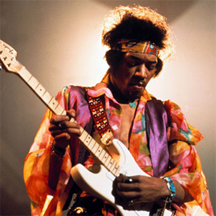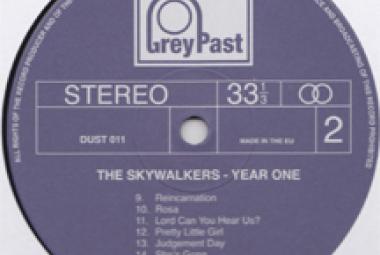Jimi Hendrix (born Johnny Allen Hendrix; November 27, 1942 – September 18, 1970) was an American guitarist, singer, and songwriter. Although his mainstream career spanned only four years, he is widely regarded as one of the most influential electric guitarists in the history of popular music, and one of the most celebrated musicians of the 20th century. He achieved fame in the US after his performance at the Monterey Pop Festival in 1967, and he headlined the Woodstock Festival in 1969 and the Isle of Wight Festival in 1970 before his accidental death from barbiturate-related asphyxia on September 18, 1970, at the age of 27. Rolling Stone ranked the three studio albums released by his band, the Jimi Hendrix Experience – Are You Experienced, Axis: Bold as Love, and Electric Ladyland – among the 100 greatest albums of all time; and they ranked Hendrix as the greatest guitarist and the sixth greatest artist of all time. (More from Wikipedia)
Another great Canadian band (from Montreal), the Haunted had a fairly big hit that has the title “1-2-5”. The last single by the Haunted is a French-language version of Jimi Hendrix’s “Purple Haze”, called “Vapeur Mauve” that is really something; the Voxx CD also includes “Pourquoi”, their French version of “Talk Talk” by the Music Machine.
(April 2013)
* * *
After auditioning the Klubs at a nightclub called the Pink Flamingo, Vic Smith signed them to a management deal with Don Arden’s company Aquarius. As a result, in early 1968, the Klubs again sort of followed in the Beatles’ footsteps and arrived at Decca Records – actually, Decca had famously decided against signing the Fab Four – where four tracks were laid down according to company records. Two were covers of the Beatles’ “Drive My Car” and Jimi Hendrix’s “Fire” – the latter song (apparently recorded at a later time) is the only cover song on the Midnight Love Cycle CD – plus their own songs “Midnight Love Cycle” and “Ever Needed Someone”. “Midnight Love Cycle” also became the title of their retrospective albums.
(July 2013)
* * *
In 1998, an organization called Native American Music Association & Awards was started in order to bring awareness of the contributions of Native Americans to music in all its forms; the Awards have been presented annually since that time. The surprise at taking even a quick glance at their “Did You Know” roster at www.nativeamericanmusicawards.com/halloffame.cfm is the incredible number of stars of popular music who have Native American blood – the tribe or confederation name(s) are given in parentheses here and elsewhere in this post: Elvis Presley (Cherokee), Jimi Hendrix (Cherokee), Hank Williams (Choctaw), Willie Nelson (Cherokee), Ritchie Valens (Yakui), Aaron Neville and the Neville Brothers (Choctaw/Cherokee), Loretta Lynn and her sister Crystal Gayle (Cherokee), Kitty Wells (Cherokee), Wayne Newton (Powhatan), Michael Jackson and the Jacksons (Choctaw/Cherokee), Link Wray (Shawnee), Richie Havens (Blackfoot), Robbie Robertson of the Band (Mohawk), Tina Turner (Navaho), Cher (Cherokee), Rita Coolidge (Cherokee), Eddie Van Halen of Van Halen (Native Hawaiian – Native Americans who are not among those often called Indians), Tori Amos (Cherokee), Toni Tennille of the Captain and Tennille (Cherokee), Billy Ray Cyrus and his daughter Miley Cyrus (Cherokee), Anthony Kiedis of Red Hot Chili Peppers (Mohican), LL Cool J (Cherokee), Beyoncé (Creole), etc.
Tommy Allsup (Cherokee) was a member of Buddy Holly’s new band in 1959; he “lost” a coin flip with Ritchie Valens and was thus not on board the airplane that crashed on the day the music died.
* * *
Redbone was formed in 1969 by two brothers from Coalinga, California, Patrick Vasquez (bass and vocals) and Candido “Lolly” Vasquez (guitar and vocals). They took the names Pat Vegas and Lolly Vegas in order to downplay the Latin American origin of their real surname (even though Las Vegas is also Spanish, meaning “meadows”).
Jimi Hendrix – who also has Native American blood – convinced them to organize an all–Native-American band. The two brothers added Peter DePoe (drums) and Tony Bellamy (lead guitar, piano, vocals).
(August 2013)
* * *
Vanilla Fudge had the good fortune to tour with Jimi Hendrix, was the opening act on several concerts on Cream’s last tour, and finally began touring with the brand-new Led Zeppelin opening for them. After hanging in there for several more albums (Sundazed Records has reissued four of them), the band broke up in early 1970.
(April 2014)
* * *
The short life of Derek and the Dominos was beset with tragedy – Jimi Hendrix died just eight days after the band laid down one of his songs for the album, “Little Wing”, and one year later, their near-bandmate Duane Allman was also gone. Eric Clapton was settling into heroin addiction while the band was on tour, and he sank into despair when this band too broke up.
* * *
On September 18, 1964 and again on September 21, the Soul Agents backed blues legend Little Walter, a fearsome blues harmonica (“blues harp”) player who was once a part of Muddy Waters’ band. Wikipedia notes that his “revolutionary approach to the harmonica earned him comparisons to Charlie Parker and Jimi Hendrix, for innovation and impact on succeeding generations.”
(May 2014)
* * *
While his music is not overtly religious for the most part, one of Lenny Kravitz’s biggest hit songs, “Are You Gonna Go My Way” seems to me to be written as a message from Jesus to humanity; the first verse is:
I was born long ago
I am the chosen I’m the one
I have come to save the day
And I won’t leave until I’m done
The music has a definite Jimi Hendrix vibe; and on the video, the musicians backing Lenny Kravitz with his flowing dreadlocks (the drummer is a woman, Cindy Blackman) look very much like the Jimi Hendrix Experience in their prime. The ceiling above the band has swirling flashes of bright light that are perfect for the music.
* * *
A noted guitar prodigy, Randy Craig Wolfe of Spirit was given his moniker at age 15 by none other than Jimi Hendrix (before Jimi started using that spelling); when they played together in 1966 in one of Hendrix’s early bands, Jimmy James and the Blue Flames, Jimi called him “Randy California” in order to distinguish him from Randy Palmer who was also in the band.
(November 2014)
* * *
The Allmusic piece on Dick Dale by Steve Huey begins: “Dick Dale wasn’t nicknamed ‘King of the Surf Guitar’ for nothing: He pretty much invented the style single-handedly; and no matter who copied or expanded upon his blueprint, he remained the fieriest, most technically gifted musician the genre ever produced. Dale’s pioneering use of Middle Eastern and Eastern European melodies (learned organically through his familial heritage) was among the first in any genre of American popular music, and predated the teaching of such ‘exotic’ scales in guitar-shredder academies by two decades. The breakneck speed of his single-note staccato picking technique was unrivalled until it entered the repertoires of metal virtuosos like Eddie Van Halen, and his wild showmanship made an enormous impression on the young Jimi Hendrix.”
(December 2014)
* * *
Kim Fowley worked with the N’Betweens and produced one of their singles, “You Better Run” that was released in December 1966; this band later evolved into Slade. Fowley also produced the flip side of the first single by the Soft Machine, “Feelin’ Reelin’ Squeelin’” that came out in early 1967. Jimi Hendrix is rumored to have played rhythm guitar on the track; he was recording “Hey Joe” at the same studio.
(January 2015/1)
* * *
The October 1964 single by the Beatles, “I Feel Fine” (included on their album Beatles ’65) is credited as the first song to use feedback in a rock recording. The band was about to leave the recording studio when John Lennon left his guitar resting against his amplifier, only to be greeted by a whine of sound. A feedback note was then added to the very beginning of the song. In one of his last interviews, John Lennon spoke proudly of this musical innovation: “I defy anybody to find a record . . . unless it is some old blues record from 1922 . . . that uses feedback that way. So I claim it for the Beatles. Before [Jimi] Hendrix, before the Who, before anybody. The first feedback on record.”
* * *
A review of the Human Zoo album by It’s Psychedelic Baby has this glowing tribute: “Parked in a musical zone owing a nudge and a wink to Vanilla Fudge, Jimi Hendrix, and Iron Butterfly, the Human Zoo perused and embodied the acid rock sounds of the day with insight and intent. Bold and booming guitars interact with crunchy keyboards and potent drum fills, while the soul-informed vocals and harmonies occasionally echo those of the heavier side of Crazy Elephant or Pacific, Gas and Electric.”
(July 2015)
* * *















